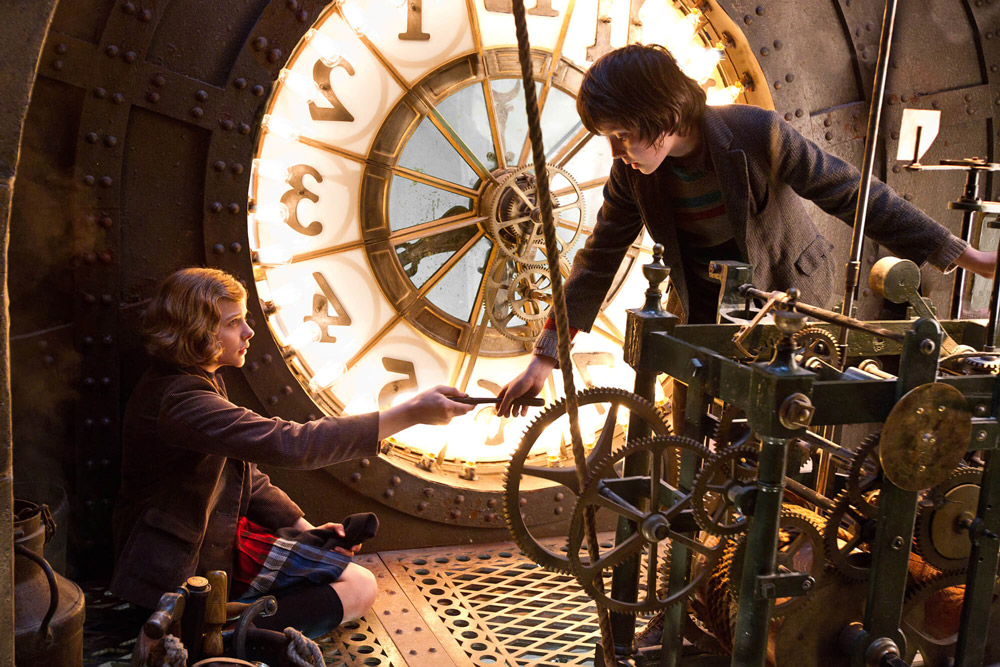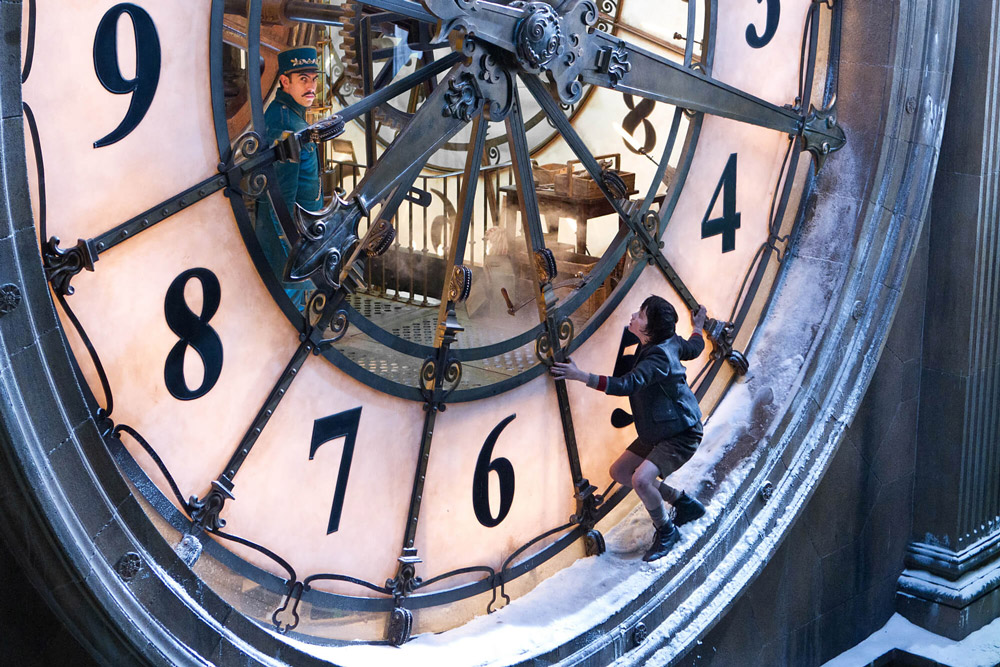
(C) 2011 Paramount Pictures. All Rights Reserved.TM, (R) & Copyright (C) 2013 by Paramount Pictures. All Rights Reserved.
``Hugo'' Martin Scorsese was actually a 3D enthusiast!
2018.12.03
About 3D effects
The 3D in this movie was not the current mainstream 2D/3D conversion, but a native 3D method that uses two cameras to shoot in stereo. The filming equipment was provided by PACE (currently CAMERON | PACE Group ), which also played an active role in Avatar , and used the company's Fusion Camera System , a half-mirror rig, equipped with an Arri Alexa digital cinema camera. .
Scorsese and Rob Richardson chose compositions that took advantage of the depth of the screen, such as the station platform and the inside of the clock tower where Hugo lives, and also emphasized the three-dimensional effect by choosing a wide-angle lens (*6). Additionally, the clock tower's complex steel frame and gear mechanisms are effective in creating a three-dimensional effect. This is because although the layers are complex, there are many holes in each object, so you can see far away. By frequently using moving shots that move around within these images, a motion parallax effect is also created.

"Hugo" (C) 2011 Paramount Pictures. All Rights Reserved.TM, (R) & Copyright (C) 2013 by Paramount Pictures. All Rights Reserved.
Additionally, the space between the subject and the background is always filled with smoke, steam, snow, and floating dust (*7). This is a measure to prevent the occurrence of the " book splitting effect " where the subject appears to be made up of overlapping thin layers. When viewed in 2D, it simply looks dusty, but when viewed in 3D, it is a beautiful light beam. Dramatic effects such as the volumetric expression of space are created. Since then, a number of films have used similar techniques, and it has now become a standard technique for 3D movies.
*6 A wide-angle lens itself has the effect of emphasizing the sense of depth based on linear perspective. On the other hand, a telephoto lens compresses the screen forward and backward, resulting in a loss of depth and the tendency to create a splitting effect. However, if you widen the angle of view too much, you will end up with an unnatural result where the subject stretches forward and backward.
*7 This floating dust was created by SFX supervisor Joss Williams who bought up feather pillows from a department store and had his mother and sister cut them into small pieces at home, a process that apparently lasted several months. . The snow issnow business companyThis is a combination of fake snowfall created by a specialist called Pixomondo and particles created by Pixomondo.
Harold Lloyd's relationship with 3D
In the film, a young girl named Isabelle (Chloë Grace Moretz) is strictly forbidden by her foster parents, Georges Méliès (Ben Kingsley), from watching movies. But one day, he and Hugo sneak into a movie theater and watch it for the first time.
The film being screened here is `` Lloyd's Pointless '' (23), starring Harold Lloyd.This depiction is also in Brian Selznick's original work , and follows the story of a railroad security officer (Sacha The Adventures of Baron Munchausen Cohen). It is also a foreshadowing of the scene where Hugo is hanging from the hands of the clock tower.

"Hugo" (C) 2011 Paramount Pictures. All Rights Reserved.TM, (R) & Copyright (C) 2013 by Paramount Pictures. All Rights Reserved.
Lloyd, along with Chaplin and Keaton, is known as one of the three great comedy kings of the world, and was a Hollywood star who was active mainly in the 1920s. In fact, the choice of Lloyd's work for this scene happened to have a special hidden meaning that even the original author was unaware of.
This is because Lloyd, like Scorsese, was an enthusiastic stereo photography enthusiast (*8). He always carried a stereo camera with him, and in 1950 he became the first president of the Hollywood Stereoscopic Association. Some of the 200,000 stereo photographs he left behind are still published in the photo books `` 3-D Hollywood '' and `` Harold Lloyd's Hollywood Nudes in 3-D! ''.
Being such a person, he naturally has a strong interest in 3D movies, and he told a reporter from the Los Angeles Times who was on the set of ` `Roid '' (23), ``I feel that there is something missing in today's movies.'' I believe that what exists is a three-dimensional effect.If the characters in a movie were to float and move like in a stereo photograph, it would be the ultimate image.The person who created such a perfect stereo movie is the one who made the mistake. "He will be the most successful person since the birth of cinema."
Although Lloyd did not actually appear in the 3D movie, in order to honor Lloyd's foresight, he made a part in ``Lloyd's Pointless'' (the scene in which Hugo and Isabelle are seen hanging from the building's large clock). (minutes) was colorized and 2D/3D converted by Legend 3D (unfortunately, this color 3D version of the footage was not used in Hugo...). This commemorates the creation of a new category, the Harold Lloyd Award (*10), in 2011 in the 3D Creative Arts Awards, sponsored by the International 3D Association (*9). This award recognizes people who have made significant contributions to the development of 3D movies, and Scorsese was selected as the second recipient for his contribution to ``Hugo''.
*8 In Japan, the poet Sakutaro Hagiwara and the film director Daisuke Ito are also famous as stereo photography enthusiasts, and they always carried a stereo camera with them.
*9 International 3D Associationwas founded in the United States in 2009 and has been in business since 2015.Advanced Imaging AssociationThe name was changed to . By the way, the author is from the Japanese headquarters here (AIS-J, former 3DU-J) has served as a judge for the Lumiere Japan Award since 2011, and in 2018, the award ceremony was held at the Inter BEE venue (Makuhari Messe) on November 14th.
*10 Other Harold Lloyd Award winners include 1st James Cameron, 3rd Ang Lee, 4th Jeffrey Katzenberg (Hidden Figures Animation), and 5th Victoria Alonso (Marvel). Studio), 6th Jon Favreau, and 7th Darla K. Anderson (Pixar Animation Studios).

